RENEGADE GARDENER™
The lone voice of horticultural reason
2015 Renegade Gardener High Spot/Black Spot Awards

01-01-16 – Victoria, British Columbia – Live, from the Royal Theatre in downtown Victoria, it’s the 16th Annual Renegade Gardener High Spot/Black Spot Awards! Polite, refined, Canadian golf-gallery applause only, please!
Tonight’s award ceremony marks the first time Canada has hosted the High Spot/Black Spot Awards. What factors led the International Awards Committee to select the city of Victoria – the “Prague of the North” – to host this prestigious event? Was it the magnificent city gardens and overall floral festoonery for which the city is famous? The majestic setting of the 102 year-old Royal Theatre? The fact that over those 102 years, no one has caught the typo in “theater?” (Just kidding, folks. You put the Queen on your money, you’d better spell it “theatre.”)
 |
| The Renegade Gardener arrives in style, having hired a private float plane for the final puddle-jump to Victoria from Seattle. |
Or was it the extraordinary refinement, sophistication and intelligence of the Canadian people? After all, if one wants to know the capital of any U.S. state, the name of the 13th U.S. president, how to convert Fahrenheit to Celsius, or open a beer bottle with the knob end of a hockey stick, ask a Canadian.
These were all contributing factors, certainly. However, the main reason for holding the event in Canada this year was the utterly nonsensical value of the U.S. dollar versus the Canadian loonie. Due to the absurd, relentless printing of money by the U.S. Treasury, the false maintaining of miniscule interest rates by the Federal Reserve Bank, and the sheer fact that we are, damn it, America, up here in Victoria, one-hundred real dollars equal one-hundred-thirty-eight Canadian! We rented this joint for a song! Let the Canadian Club rye and Molson beer flow!

And take your seats. It’s time to give out some awards!
 High Spot Award
High Spot Award
Best Succulent Garden
The photo of this funky succulent garden growing on the dash of a compact car zipped all over the Internet this year, at least within the universe of plant nerd friends and even nerdier gardening sites and Facebook groups to which The Renegade Gardener is linked.
So rampant has been the photo’s run that the name of the gardener/auto owner has been lost. Anyone out there knows who it is, shoot us an email, so we can send the award via courier to this richly deserving individual.
High Spot Award
Coolest Example of How Nature Rules:
2,000 Year-Old Seeds From Extinct Tree Germinate and Grow
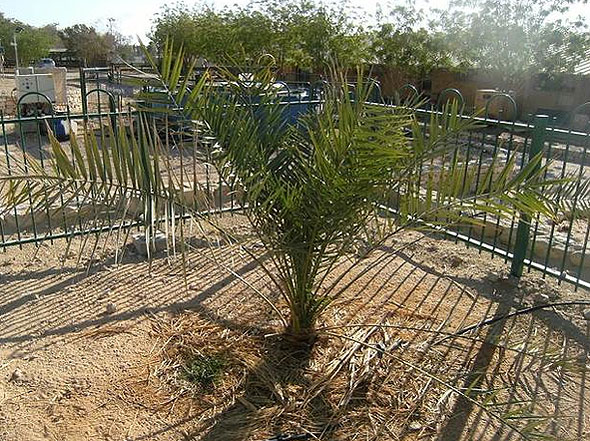 |
| Recent photo of the Judean date palm tree. |
For thousands of years, Judean date palm trees were one of the most prolific and important trees in the Middle East. First, they were a highly cultivated food crop – their sweet, edible fruit was a staple of people in the region. Second, they were planted in great number for the protective shade they provided from the deathly hot desert sun.
But watch out – here come the Romans. Seeking to gain control of the region around 70 AD, the Roman armies cut down, dug up, burned and destroyed every Judean date palm tree in their path, to the point that by 500 AD, the plant had become extinct. Referenced in the Bible and described in detail in other writings from the period, by the onset of the modern era the tree was known only in legend.

Then in the 1960s, during excavation at the site of Herod the Great’s palace in Israel, archeologists uncovered a small number of seeds in a clay jar carbon dated back 2,000 years. For the next 45 years, the jar containing the seeds was stored in a drawer at Tel Aviv’s Bar-Ilan University. Finally, in 2005, botanical researcher Elaine Solowey decided to plant one seed, to see if it possibly could sprout.
It did, producing a sapling not seen in thousands of years, becoming the oldest known tree seed to germinate. Not only did it sprout, it grew, taller and broader, then began to flower after six years. It is now reaching fruiting maturity. This once great tree is back from the dead – because it actually never died.
When I think hard about it, this is what captivates me most about gardening. You’re not paying attention if practicing the hobby doesn’t cause you to ponder this thing called “life.” No one can see it. Scientists can’t chart or photograph or capture or explain it. It’s just there, in this case, resting patiently, vibrantly, biding its time for over 2,000 years inside a seed in an ancient clay jar.
Waiting, for soil, sun and moisture. It blows my mind.
High Spot Award
Small Tree of the Year: Cornus alternifolia‘W. Stackman’
Common Name: Pagoda Dogwood ‘Golden Shadows®’
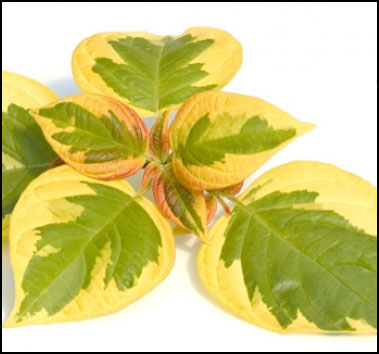 If you are searching for a stunningly gorgeous small tree to be planted in a partially shaded spot of supreme visual importance, look no further. This recent introduction is as striking a small tree as can be grown.
If you are searching for a stunningly gorgeous small tree to be planted in a partially shaded spot of supreme visual importance, look no further. This recent introduction is as striking a small tree as can be grown.
New growth emerges with hues of reddish orange, maturing to large, bright yellow, heart-shaped leaves with an inner, irregular flush of green, each leaf as unique as a snowflake. Extremely attractive, lacy white spring flowers make one want to kneel before it and beg forgiveness for all past and future sins. Fall color is unexceptional, but wait until winter, when the naturally layered appearance of the branching habit, now free of leaves, converts the plant into elegant sculpture.
The tree is deer resistant, and the navy blue berries that appear in mid-summer attract birds.
Care and Use
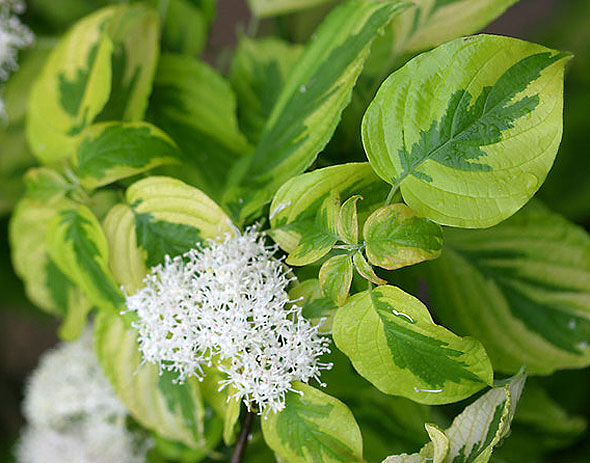
‘Golden Shadows’ will grow in any soil that provides decent drainage, but is at its best when planted in slightly acidic soil that has been amended with organic material. Leaves will scorch in full, all-day sun, so choose a spot with light dappled shade, morning sun/afternoon shade (or vice versa) or a location that does not exceed five hours of direct sunlight.
The plant is relatively slow growing. If left unpruned, the tree will grow between ten to fourteen feet tall, depending on zone and site conditions. Crown spread is typically ten to twelve feet after twenty years. As for pruning…
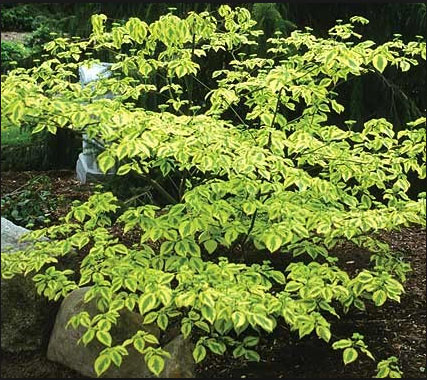
It’s part of the fun of growing a padoga dogwood. Plant it and leave it alone for five years. You may decide you like what you see, and never prune. However, if you are interested in creating a living sculpture, pruning branches alternately at the main trunk to accentuate the natural horizontal staggering of branches is a nifty and fulfilling practice in which to engage. The tree achieves a sophisticated look unmatched in botany. Over the course of a decade, one would remove between fifty and sixty percent of the overall branch growth.
Branches grow clear down to the base, so at the very least, pruning off these base branches so you may plant groundcovers around the base is a fine idea.
Plant ‘Golden Shadows’ as a single specimen, keeping in mind mature width, in a space of visual prominence. Hardy to USDA Zone 3, with a growing range of zones 3-8.
Black Spot Award
Still the Most Annoying Marketing Campaign:
Nursery Industry Collusion with Pantone Color of the Year
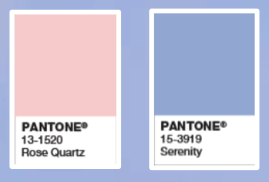 We were going to ignore it this year, the judges and I well aware that we’re beating a dead horse with yet another mention of this too precious campaign. Gardeners somehow are to become excited that the color chosen by a commercial marketing company as next year’s clothing, paint and kitchen appliance design anchors somehow bear enough gravitas to engender their inclusion in the garden.
We were going to ignore it this year, the judges and I well aware that we’re beating a dead horse with yet another mention of this too precious campaign. Gardeners somehow are to become excited that the color chosen by a commercial marketing company as next year’s clothing, paint and kitchen appliance design anchors somehow bear enough gravitas to engender their inclusion in the garden.
Then they went and doubled-down. For 2016, they’ve announced TWO colors, a pink and a blue. Why two shades? As included in the announcement by the Pantone people, “Rose and blue represent female and male, and the blending of the two represents a blurring of gender as it relates to fashion.”
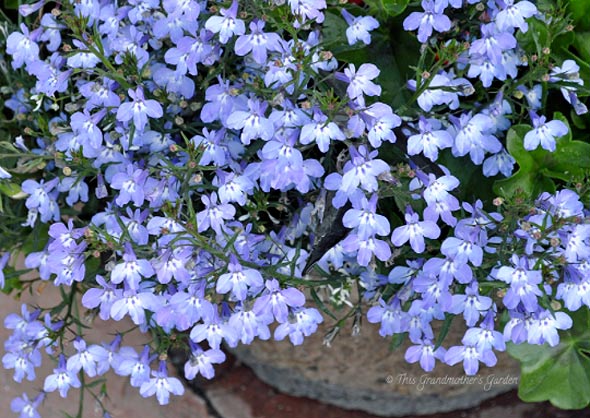 |
| Lobelia Hot Springs ‘Sky Blue’ |
Just when you thought it was fashionable to go back in the garden. The major plant growers who feed the nursery industry have jumped in immediately, of course, doing what they do every year, releasing photos of blooming plants with flowers that vaguely match the new color(s).
Ball FloraPlant, a major player, is touting Lobelia Hot Springs ‘Sky Blue,’ an old plant that approximates the Pantone blue. They must have a lot of them in inventory. A second plant, Geranium Fantasia ‘Pink Shell’ doesn’t come close to matching the pinkish “rose quartz” selected by Pantone. Plus, that’s all we need, another zonal geranium.
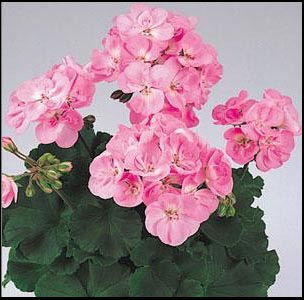
Geranium Fantasia ‘Pink Shell’
Likewise, Selecta, another giant wholesale grower, has been promoting their annual, Lobelia Magedi ‘Electric Blue,’ in conjunction with the 2016 Pantone colors, another old plant that doesn’t come even close to Pantone 15-3919. Maybe they figured no one would notice. Maybe they’re close to being onto something: no one cares.
Proven Winners has responded by recommending a number of lovely annuals plus a hydrangea variety, oblivious to the fact that if you plant a shrub, in 2017 your garden is sitting there wearing last year’s dress. My advice in this case is to hang in there, grow it for 15 years, and wait for the matronly shrub to come back in style.
Worst of all, every grower blew it, more proof that The Renegade Gardener should be in charge of everything. Were I running a major nursery, I’d have announced a full spectrum of hermaphrodites, plants that contain both the male stamen and female stigma (monoecious), of which there are numerous. Roses, day lilies and many varieties of deciduous and evergreen trees are monoecious plants.

Rosa ‘Peach Drift.’ There. Done.
So if you absolutely MUST succumb to this nonsense, my advice is plant a drab, salmon-colored shrub rose, such as ‘Peach Drift.’ Now you’re covering all the bases – even if you are the only person in the universe who knows it.
High Spot Award
Best Gardening Advertising Campaign:
The Southern Nevada Water Authority TV Ad Against Overwatering
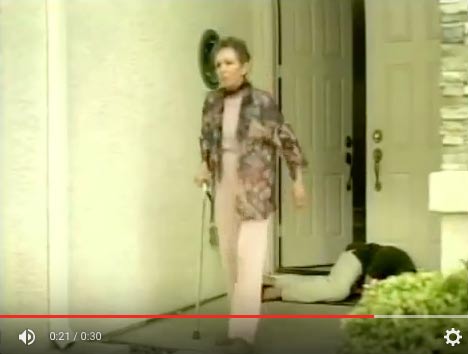
With portions of the country currently experiencing drought, researchers at the SNWA found that 70% of the state’s water was being wasted by men overwatering their lawns (well, duh). So the state agency took the bull by the horns (close to literally), and produced a series of television commercials that have not only won numerous “Funniest TV Commercial” awards, they are credited with helping the state achieve a 30% reduction in water usage.
To view one of the short commercials (oh, you must), click here.
High Spot Award
Gardener of the Year: The Embattled Ms. Sarah Baker
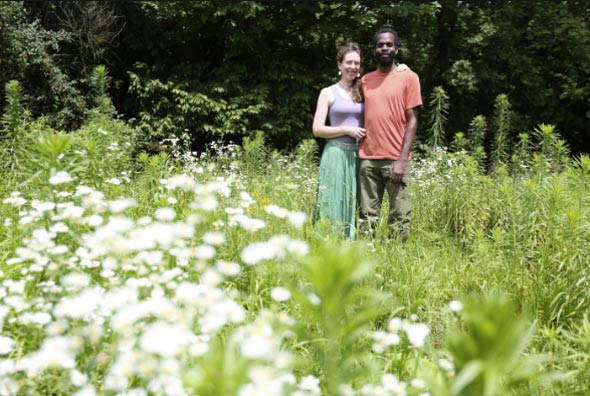
When Sarah and her boyfriend, Daryl, opted to stop mowing their lawn and allowed their nearly one-acre property to go natural in the small town of Alexandria, Ohio, little did they know the mayhem that would ensue. News of the homeowner’s scandalous behavior spread across the country more quickly than the Emerald ash borer, becoming a topic of radio talk shows, newspaper articles and even resulting in an editorial by Sarah being published in The Washington Post.
Moving into what had been an abandoned house in 2011, Sarah mowed the lawn “like a normal person” for two years, then began experimenting, letting portions of the yard go natural. Noxious weeds such as burdock, thistle and ragweed, prominent on the property at time of purchase, as well as weeds such as dandelions, were carefully pulled and eliminated.
The daughter of nursery owners, who opened Baker’s Acres Greenhouse in 1980, Sarah was well versed in the world of horticulture, slowly transitioning the lawn area by encouraging and planting native perennials and grasses.
All was well until, of course, local government stepped in. Three trustees of the Licking County St. Alban’s Township sent a letter to inform Sarah that her yard didn’t meet the community standard and posed a risk to the community’s “health, safety and welfare.” In addition, some neighbors had complained. If they didn’t mow in ten days, the city would send someone over to do it.
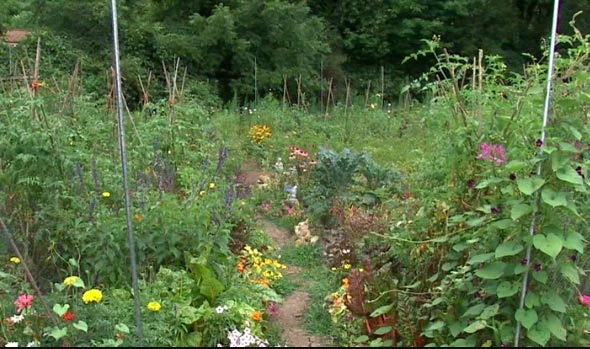 |
| A portion of the Baker property. |
The situation went back and forth, back and forth, the township calling it a “nuisance,” while Sarah pointed out she takes more time to maintain the property than people who mow. Friends and neighbors began attending the hearings in support of Baker.
“Weeds are weeds, it’s not debatable” said one Trustee. “It’s very debatable,” countered Baker. “Many are beneficial plants. Even on a small piece of property like this, you can make your own wildlife sanctuary, you can build a working, living ecosystem that’s self-contained, that has checks and balances.”
“We’re a land of laws,” insisted another Trustee. “We have to adhere to them, too. We have to do what we’re told to do.”
Government eventually won, forcing Sarah and Daryl to mow down their native prairie and grassland in the front and one side yard to a height of six inches – they used a scythe – but the battle isn’t over. Baker refuses to revert the property to traditional lawn grass, and come spring, what will grow of the debate is anyone’s guess.
“It’s beautiful,” says Baker of the property. “And I know a lot of people don’t think it’s beautiful. But when you live in it and you interact with it and you observe it, you can see all the nature that a mowed lawn is displacing.”
What’s my editorial take on this? Yes, there are sound reasons for zoning laws. These laws are needed to protect homeowners from yahoo neighbors who don’t maintain their property, don’t mow their lawn, period, and allow weeds such as dandelions to prosper and blow their seeds all over the neighborhood. Now you have a situation where the rights of one person infringe on the rights of others.
In this case, I side with Ms. Baker. In instances such as these, city governments should rule on a case-by-case basis (which of course they hate to do).
Ms. Baker’s yard was not a small city lot, sitting on a block surrounded by a dozen other homes. Even if a neighbor in an area of wooded, large properties considers a carefully maintained, naturalized habitat to be an eyesore – and good luck defining that in a court of law – is the neighbor’s opinion not based on the premise that a neatly mowed, grass lawn is some form of statutory law? It isn’t, at least not in Alexandria, Ohio.
Credit and thanks to The Columbus Dispatch and TV10, Ohio, for information and quotes used in this article.
High Spot Award
Most Important Scientific Breakthrough:
University of Florida Scientists Develop Disease-Resistant Citrus Trees
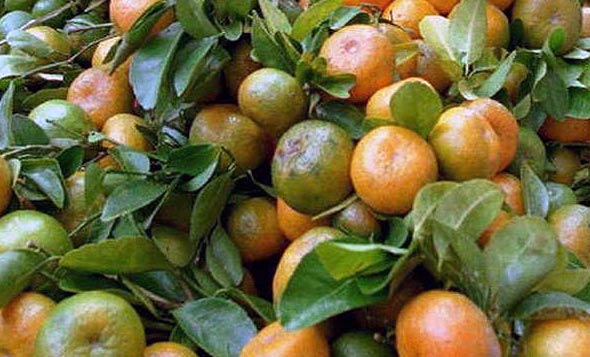 |
| Oranges infected by citrus greening. |
Huge, HUGE problem, one that impacts you, so listen up: A disease known as citrus greening currently threatens to destroy Florida’s $10.7 billion citrus industry. You’re no doubt familiar with oranges, grapefruit, lemons and limes? Florida growers produce nearly seventy percent of these citrus fruits sold in American and Canadian markets.
A deadly disease named Citrus Greening threatens to destroy Florida’s citrus industry, and over time wipe out all citrus trees on the planet. The culprit is the tiny Asian citrus psyllid, which sucks on leaf sap and leaves behind toxic bacteria. The bacteria moves through the tree and starves the plant of nutrients, until the trees produce green, misshapen fruits unsuitable for eating or for manufacturing juice. Trees eventually die. The disease has already infected over one million citrus trees in North America.
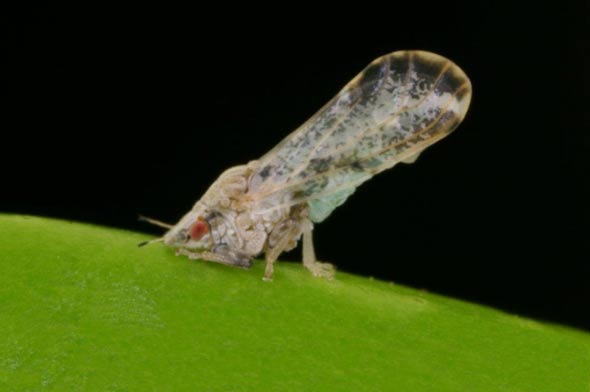
Asian citrus psyllid, about the size of a pinhead, brought to us courtesy of Mother Nature.
Basically, we’re doomed, in terms of being able to buy and consume fresh citrus fruits in the future. Enjoy that orange – it could be your last. Plus you’ll need to adjust your diet to get enough vitamin C.

Professor Jude Grosser, University of Florida
But wait – Jude Grosser, a professor of plant cell genetics at the University of Florida’s Institute of Food and Agricultural Sciences, aided by research assistant Manjul Dutt, used a gene isolated from Arabidopsis thaliana – a small flowering plant in the mustard family, which includes cultivated species such as cabbage and radish – to create new citrus trees resistant to greening, including trees that have remained disease-free for 36 months after planting in fields containing a high number of diseased trees.
It will take several decades, but it appears that cultivation of these disease-resistant trees will keep citrus fruits from becoming extinct on the planet, in addition to saving nearly 100,000 jobs and a billion-dollar industry. Keep your fingers crossed.
And be damn sure you understand exactly what scientific technique is responsible for saving Florida’s, and world’s, citrus supply: Genetic Engineering. Professor Grossner’s genius work in genetic engineering, and the resulting GMO oranges, grapefruits, lemons and limes, could very well earn him a Nobel Prize.
That’s what genetic engineering, and genetic modification (GMO) is all about. I love it how so many ignorant dissenters think that GE and GMO food technologies were developed for the hell of it, just scientists tinkering because they were bored. No. These brilliant, often underpaid humanitarians are concerned with trying to feed a planet, and to stay ahead of a thousand natural plant diseases and hundreds of insect pests threatening to disrupt and even destroy the human food supply.
You’ve heard of famine, in historical references, down through the ages? Or across the African continent, in our lifetime? It happens when nature destroys man’s food sources via insects, rusts and fungi. It has occurred for thousands of years, and is occurring today. Twenty, fifty, one-hundred years ago, what would have resulted from citrus greening? Citrus trees would have been wiped out, and today, the only awareness you would have of oranges would be through archival photos.
To quote plant geneticist Pam Ronald, University of California-Davis, a woman devoting her life to ensuring the safety and abundance of the world’s food supply:

I’m with you, Pam. Sadly, her words apply just as aptly to well-fed citizens of first world countries. I get so tired of scientifically illiterate, wholly clueless, layman protesters and activists in the US banging their fists down on tables brimming with fresh food, and screaming, “We’ve got to stop golden rice!”
High Spot Award
Coniferous Plant of the Year: Picea pungens ‘Procumbens’
Common Name: Blue Creeping Colorado Spruce
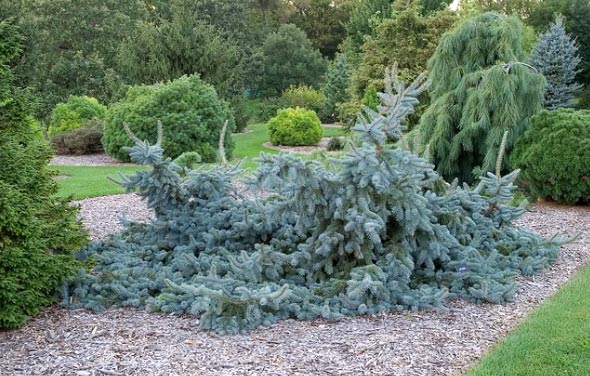
A very old ‘Procumbens’ specimen, various leaders trained with stakes to create a jutting vertical habit.
You’re a person who likes your evergreens upright, broad at the base, tapering narrow to the top, as God intended? ‘Procumbens’ is not for you. Don’t understand how an evergreen with a mostly prostrate growth habit can be considered attractive? Stop paying attention. Need an evergreen you can decorate with lights for Christmas? Skip ahead to the next award.
If, however, you want a jarringly beautiful evergreen that over the years turns into the botanical equivalent to poetry, the visual equivalent to bebop jazz, I have just the plant for you.
Silvery-blue needles retain their rich color year round. New spring candles average four to ten inches long, meaning that even a small starter specimen begins to gain attention in a mere two to three years. Plants rarely exceed twelve inches in height until 10 years, unless a candle or two are selected and trained upward (a fun amusement). Width can reach 10 feet at maturity, though the plant can be pruned to maintain virtually any desired width.
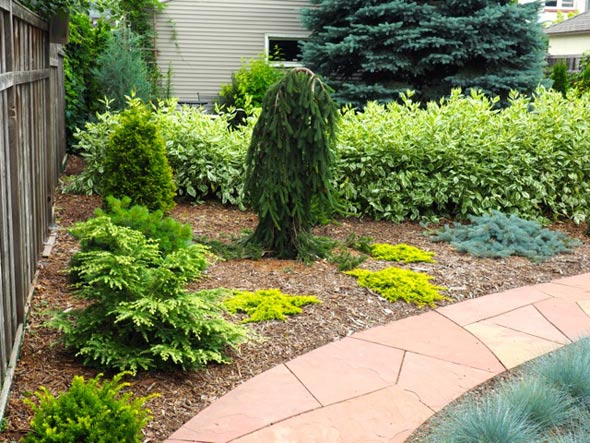
A young specimen (far right side, middle) in a client’s conifer garden.
Care and Use
This is another specimen evergreen, meaning, plant it as a single near the front to middle of the bed where it can be readily seen. Surround it with deciduous and evergreen plants featuring gold, yellow, green, red and burgundy foliage. It is fantastic in close proximity to stone outcroppings.
Plant in full sun. ‘Procumbens’ is not terribly concerned about soil type, though it will suffer in soil that remains wet for extended periods of time. Plants become quite drought tolerant once established. Plants are extremely cold hardy, to USDA Zone 2, with a growing range of zones 2-8.
Black Spot Award
Most Glaring Statement That the Gardening Industry Still Doesn’t Get It
One of the headline speakers at the Independent Garden Center (IGC) East conference this summer has it all figured out, stating in his address that, “If we (garden centers) don’t provide a multifunction, multi-benefit solution for what they’re looking for, young consumers just don’t have time for it. A pretty flower just doesn’t cut it.”

The only photo I could find.
So the good news for nursery owners, I guess, is that they can stop ramming all those pretty, colorful annuals and perennials in racks at their front entrances, even though studies show that nearly thirty percent of plant purchases are impulse buys of pretty flowers displayed at the entrance. Yeah, to hell with plants, let’s focus on providing multifunction, multi-benefit solutions. That’ll turn things around.
High Spot Award
Best Good News: Gardening Industry Shows Economic Growth
Year-end numbers point to an increase in the amount of expenditures on gardening products by American consumers, even prior to implementing the new call for multifunction, multi-benefit solutions.
It had to happen at some point. After more than a decade of steady decline, including precipitous drops in spending over the past seven years, gardening as an industry pulled out of its nosedive and gained some upward momentum heading into 2016.
Among the good news:
- Nursery sales for the key months of April and May, 2015, were up almost ten percent from 2014.
- Sales of trees and shrubs increased eight percent from 2014.
- Government data shows that nearly one in three American households are growing their own food, the highest level seen in a decade.
According to IBISWorld, a leading market research firm, 2015 industry profit margins and overall employment figures show very little change from recent years, but they are forecasting mild growth in overall consumer expenditures through 2020. Consumer spending related to gardening is highly contingent on weather and housing starts, so anything can happen, but it’s a positive sign.
Black Spot Award
Worst Bad News: Desire for Low-Maintenance Is Top Priority

Low-maintenance? The least important consideration to a true gardener.
A 2015 study conducted by the American Society of Landscape Architects (I’ve, um, heard of them) has found that when it comes to gardening, low-maintenance yards and landscapes are the top priority for American homeowners. Following close behind in the number two spot is “sustainability,” whatever that means.
This is not good news. There is, of course, no such thing as a low-maintenance landscape, unless every inch of your property is grass lawn with automatic sprinkler system, you hire a lawn service to mow it all season, and write a check to your sprinkler guy twice a year.
Native landscapes? You still need to water, and weed, and learn how plant, divide and prune. Failing to maintain a native landscape, unless you live in a remote rural area, will result in complaints from neighbors and a warning letter from your city just as quickly as not maintaining a conventional landscape – perhaps quicker.
What the findings say, in no uncertain terms, is that fewer and fewer people are interested in gardening, in researching, selecting and planting trees, shrubs, perennials, and annuals. Gardening as in outside of growing grass.
The increase in garden-related expenditures noted in the award above this one means simply that the weather was, overall, conducive to gardening this year, housing starts were up, and the dwindling number of true gardeners got off their duffs and went at it.
High Spot Award
Perennial of the Year: Euphorbia wulfinii ‘Shorty’
Common Name: Evergreen Spurge
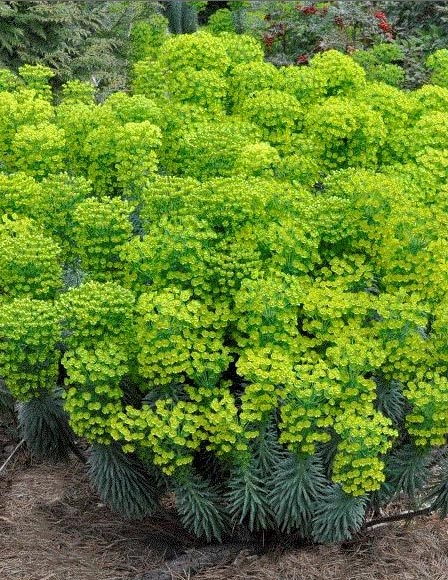
This dwarf variety of Euphorbia wulfinii makes a huge impact in the landscape, with the added benefit of remaining stout and full throughout the growing season. Too many Euphorbias look fab in spring and early summer, but splay out and mat down by early fall.
Mounds of green, you may say? To me, the guy who’s all about colorful foliage? Hey, green is a color, and if you are using a wide pallet of rich shrub and perennial foliage colors in your gardens, a swirling river of soothing green ‘Shorty’ meandering through a portion of the proceedings is just the thing.
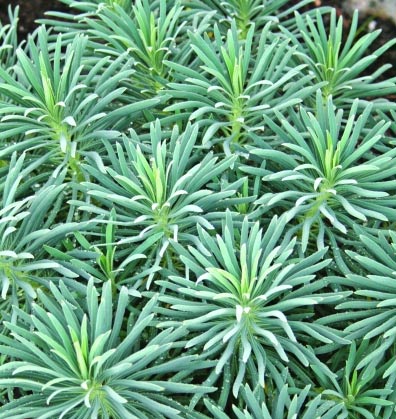
Foliage emerges blue-green in spring with red tips. Large clusters of yellow flowers magnified by surrounding bracts appear early in the season, turning light green and contrasting with beautiful subtlety to the bluish foliage.
Care and Use
Plant ‘Shorty’ in full to part sun, in any type of soil that has some drainage. This is a plant you want to use in swaths, snaking here and there. Also suitable for containers – plant it as a single in a small to medium pot. Plants grow upwards to 18” tall by midsummer. It self-seeds quite readily, meaning it fills up a space quickly. The leaves are evergreen in Zones 7-9, providing terrific winter interest.
Listed as hardy to Zone 7 in some places, to Zone 5 on some sites I trust, I’ll tell you right now it has not been trialed in Zone 4, and would be worth experimentation. Remember that ‘Bonfire,’ a fabulous reddish Euphorbia, began its nursery career as hardy only to Zone 7, until it was learned that it was perfectly hardy to Zone 5, and ultimately, to the forbidden Zone 4.
Black Spot Award
Tallest Mulch Volcano: Roger and Michelle Davidson, Chinese Elm, Los Angeles, CA
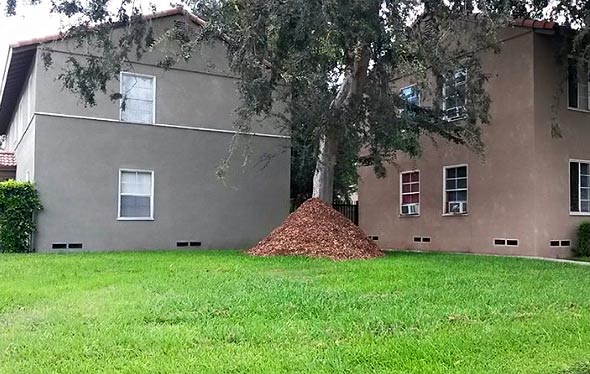
Sparing no expense, I dispatched one of the judges, armed with a tape measure, to the Davidson property in the Canoga Park neighborhood of Los Angeles. He confirmed that at a height of forty-nine and three-eights inches, this homeowner-contrived mulch volcano exceeds that of the previous record holder, Lars Bjorkland of Tofte, Minnesota (forty-eight and one-quarter inches).
The Davidsons are breathlessly awaiting verification from the Guinness World Record committee.
High Spot Award
Best New Gardening Product of the Year: Nitrile Coated Gloves
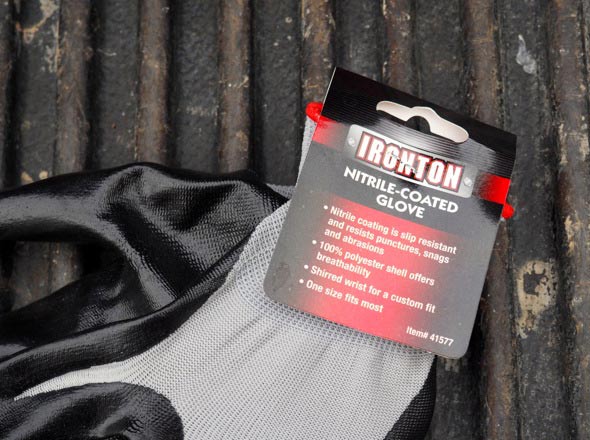
Gloves are a big deal to me. First, I’m a landscaper. Second, I’m a gardener. Third, I play a gardening expert, on the Internet, in books, and on TV. My gloves fail me, I fail you.
Nitrile gloves are one of the greatest advancements in gardening in my lifetime, and I’m being serious. Leather gloves are ungainly, they get hot and turn your hands into prunes when wet. Cloth gloves are worthless, they never fit tight, don’t prevent callouses and are downright dangerous when using machinery.
Then along came lightweight synthetic gloves with a palm and finger coating of standard rubber. They offered vey good protection to palms and fingers when wielding a shovel, rake or pruner. The only problem was they wore out, frayed, and started falling apart in two months or less of regular gardening. Washing them only speeds this process.
On the landscaping job site, where I’m wielding a stone saw, hand anvil, chisels, shovels, rakes, loppers and pruners, a pair might last me three weeks.
The newest advancement in gloves is the coating of nitrile, a synthetic rubber copolymer of acrylonitrile (ACN) and butadiene. It’s tough as nails. If the gloves get wet, leave them on – they dry in about ten minutes. The material is so thin, you can leave them on when removing plant tags, tying knots and flicking a lighter (to light your butane torch when repairing a client’s plastic lawn irrigation hose that I just ripped out with my Bobcat). When dirty and crusty from mud, toss them in the washing machine.
A pair of nitrile-coated gloves will last me almost six months of daily use – a steady 40 hours a week. One pair should last you two or three seasons of normal gardening use. They’re not even expensive – the pair pictured cost about twelve bucks.
Black Spot Award
Worst New Gardening Product of the Year: FTD Dyed Roses
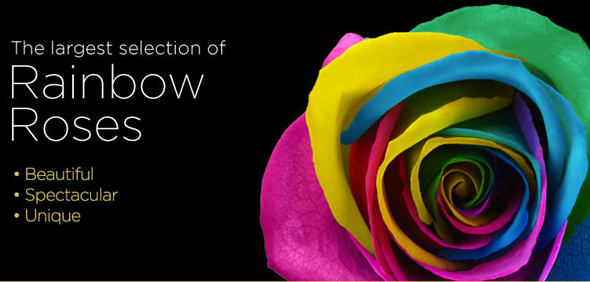
| What does it say about a company when they decide that the product they’ve been selling for over 100 years – cut flowers – could be made more attractive to consumers by dying the petals a broad spectrum of wholly unnatural colors? |  |
| The “Rainbow Roses” line of one- and two-dozen rose bouquets is being marketed as “Beautiful” (in the blind eye of the beholder, I guess), “Spectacular” (as in, spectacularly poor taste) and “Unique” (need I remind you that Echinacea purpurea ‘Doubledecker,’ the ugliest cultivated perennial of all time, is unique). |  |
| $70 to $80 per dozen is a lot to shell out for real roses rendered completely fake. Why not make them out of paper, and to hell with having to grow roses? Think of the profit margin in THAT. Both customers and recipients would never be able to tell the difference, plus the bouquet would last for years, requiring only light dusting with a feather wand every few months or so. | 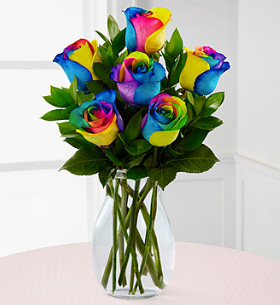 |
Wait a minute – use recycled, post-consumer paper! Then you could promote the whole green/enviro-friendly/sustainable angle and pitch it as a multifunction, multi-benefit solution to Millennials. I SHOULD BE GETTING PAID FOR THIS!!
Alas, I stagger into 2016 as ever before, hopeful, suspicious, gleefully cynical, woefully optimistic and cheerfully depressed. At least I can look forward to tomorrow’s planned activity, a private tour of the magnificent Butchart Gardens, located just up the road.
Thank you so much for attending. This concludes this evening’s program.

Don Engebretson
The Renegade Gardener
- The 2018 Renegade Gardener High Spot/Black Spot Awards January 5, 2019
- The 2017 Renegade Gardener High Spot/Black Spot Awards January 1, 2018
- The 2016 Renegade Gardener High Spot/Black Spot Awards January 1, 2017
- The 2015 Renegade Gardener High Spot/Black Spot Awards January 1, 2016
- The 2014 Renegade Gardener High Spot/Black Spot Awards January 7, 2015
- The 2013 Renegade Gardener High Spot/Black Spot Awards January 1, 2014
- The 2012 Renegade Gardener High Spot/Black Spot Awards January 4, 2013
- The 2011 Renegade Gardener High Spot/Black Spot Awards January 1, 2012
- The 2010 Renegade Gardener High Spot/Black Spot Awards January 1, 2011
- The 2009 Renegade Gardener High Spot/Black Spot Awards January 1, 2010
- The 2008 Renegade Gardener High Spot/Black Spot Awards January 1, 2009
- The 2007 Renegade Gardener High Spot/Black Spot Awards January 3, 2008
- The 2006 Renegade Gardener High Spot/Black Spot Awards December 20, 2006
- The 2005 Renegade Gardener High Spot/Black Spot Awards December 9, 2005
- The 2004 Renegade Gardener High Spot/Black Spot Awards January 1, 2005
- The 2003 Renegade Gardener High Spot/Black Spot Awards November 19, 2003
- The 2002 Renegade Gardener High Spot/Black Spot Awards October 31, 2002
- The 2001 Renegade Gardener High Spot/Black Spot Awards October 16, 2001
- The 2000 Renegade Gardener High Spot/Black Spot Awards October 20, 2000